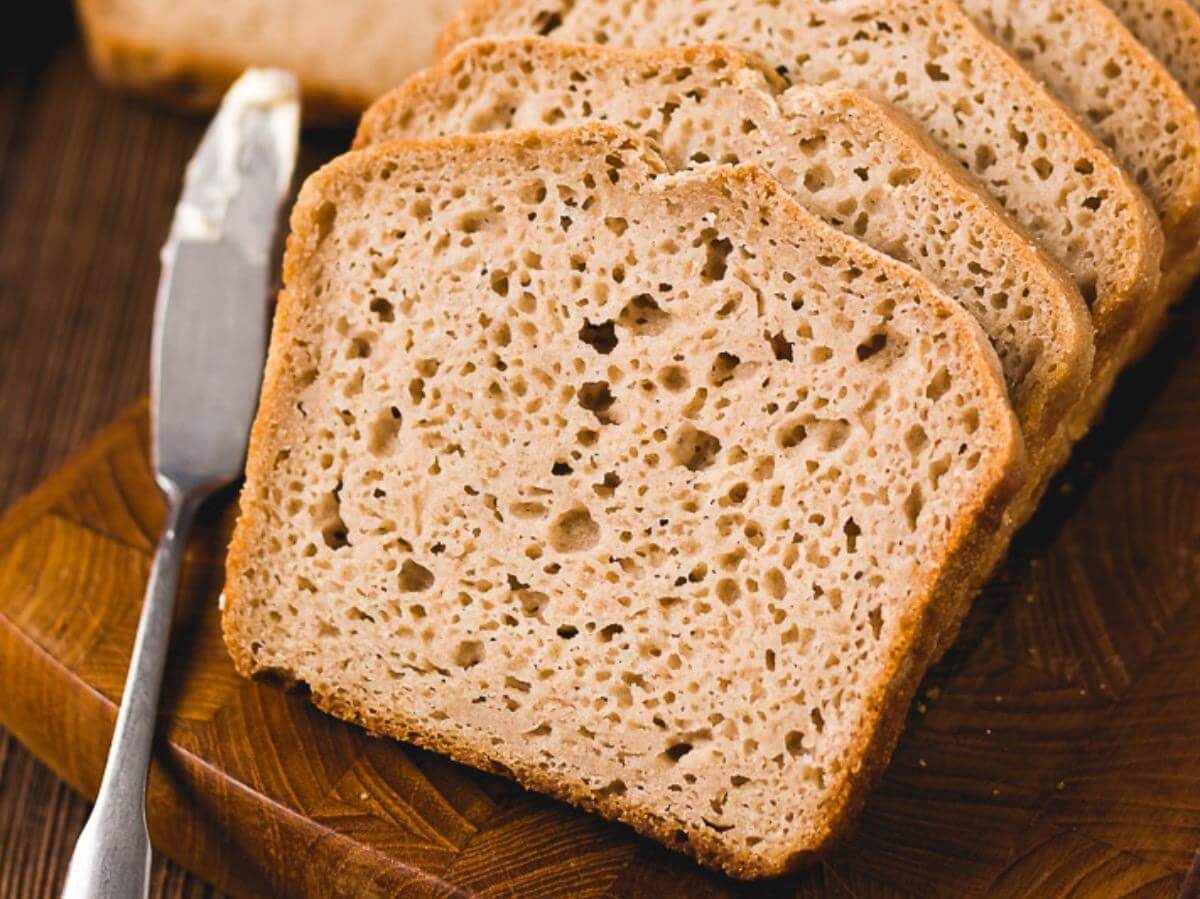
When it comes to choosing the right bread for a gluten-free diet, it’s important to have all the facts. Gluten-free bread has gained popularity in recent years as more and more people are adopting gluten-free lifestyles due to health reasons or dietary preferences. Whether you’re celiac, gluten intolerant, or simply looking for a healthier alternative, understanding the nutrition facts of gluten-free bread can help you make informed choices.
In this comprehensive article, we will dive into the details of gluten-free bread nutrition facts. From calories and macronutrients to vitamins and minerals, we will cover it all. So, sit back, relax, and get ready to discover the nutritional benefits of gluten-free bread and how it can fit into your healthy eating plan.
Key Takeaways:
- Gluten free bread is a nutritious alternative to traditional bread, offering fiber, vitamins, and energy. It’s great for people with gluten sensitivities and can be part of a balanced diet for anyone.
- While gluten free bread may be pricier and have a different texture, it’s a versatile and accessible option for those with gluten intolerance. It’s also a tasty and healthy choice for anyone looking for a change from regular bread.
Facts 1: Gluten free bread is made from alternative flours.
Gluten free bread is primarily made from flours such as almond flour, rice flour, tapioca flour, or a combination of these. These alternative flours provide a suitable substitute for wheat flour while ensuring that the bread is free from gluten.
Facts 2: It is a rich source of dietary fiber.
Gluten free bread often contains higher amounts of dietary fiber compared to traditional wheat bread. This is because it uses fiber-rich ingredients like seeds, whole grains, and psyllium husk which contribute to a healthier digestive system and promote regular bowel movements.
Facts 3: It is lower in calories than regular bread.
Switching to gluten free bread can be a good option for individuals watching their calorie intake. It typically contains fewer calories per slice compared to regular bread, making it a suitable choice for those looking to manage their weight.
Facts 4: It is a good source of essential vitamins and minerals.
Gluten free bread is often fortified with essential vitamins and minerals to compensate for the nutrient deficiencies that may arise due to the absence of wheat flour. Common fortifications include vitamins B1, B2, B3, and iron, ensuring that you still get important nutrients in your diet.
Facts 5: It provides energy for the body.
Gluten free bread is a great source of carbohydrates that provide the necessary energy for our bodies. This makes it a suitable option for individuals who lead active lifestyles or engage in sports and exercise.
Facts 6: It can be part of a balanced diet.
Including gluten free bread as part of a balanced diet can provide necessary nutrients while catering to those with gluten sensitivities or celiac disease. It can be enjoyed as part of breakfast, lunch, or as a snack.
Facts 7: It can be made with natural and organic ingredients.
Many gluten free bread options are made with natural and organic ingredients, ensuring that you are consuming a product free from pesticides, additives, and artificial flavors. This makes it a healthier choice for individuals who prioritize organic food consumption.
Facts 8: It is suitable for individuals with gluten intolerance or celiac disease.
For individuals with gluten intolerance or celiac disease, gluten free bread provides a safe alternative that allows them to enjoy bread without experiencing adverse reactions. It helps them maintain a gluten-free lifestyle and avoid gluten-related health complications.
Facts 9: It may improve digestion and gut health.
The use of alternative flours and fiber-rich ingredients in gluten free bread can help promote healthy digestion and improve gut health. The inclusion of ingredients like chia seeds, flaxseeds, and psyllium husk can support a balanced gut microbiome and enhance overall digestive function.
Facts 10: It can be a versatile ingredient.
Gluten free bread can be used in various culinary preparations and recipes, such as sandwiches, French toast, breadcrumbs, croutons, and even as a base for pizzas. Its versatility allows for the creation of diverse and delicious gluten free meals.
Facts 11: It is a suitable option for people with wheat allergies.
Individuals with wheat allergies can safely consume gluten free bread as it eliminates the risk of allergic reactions associated with wheat consumption. It provides a safe and enjoyable alternative for those with specific dietary restrictions.
Facts 12: It comes in different flavors and varieties.
Gluten free bread is available in a wide range of flavors and varieties, catering to different taste preferences and dietary needs. Whether you prefer plain, multigrain, cinnamon, or seed-infused bread, there is a gluten free option to satisfy your cravings.
Facts 13: It is easily accessible.
Gluten free bread is now readily available in most grocery stores, health food markets, and online retailers. This makes it convenient for individuals following a gluten-free diet to find suitable options without compromising on taste or quality.
Facts 14: It can be more expensive than regular bread.
Due to the use of specialized ingredients and production processes, gluten free bread can be priced higher than regular bread. This is something to consider for individuals on a tight budget or when purchasing gluten free bread on a regular basis.
Facts 15: It may have a different texture and taste compared to wheat bread.
Gluten free bread often has a different texture and taste compared to traditional wheat bread. Some people may find it denser, with a slightly nutty or grainy flavor. However, with the variety of options available, it is still possible to find gluten free bread that closely resembles the taste and texture of wheat bread.
Facts 16: It can be frozen for future use.
Gluten free bread can easily be stored in the freezer for extended shelf life. This allows individuals to buy in bulk and have gluten free bread readily available without worrying about it going stale or spoiling quickly.
Facts 17: It is a suitable option for individuals on a gluten-free diet.
For individuals following a gluten-free diet, gluten free bread is a crucial staple that provides a sense of normalcy and satisfaction. It allows them to enjoy sandwiches, toast, and other bread-based dishes without compromising their dietary restrictions.
Facts 18: It can be enjoyed by anyone, even those without gluten sensitivities.
While gluten free bread is specifically designed for individuals with gluten sensitivities or celiac disease, it can be enjoyed by anyone looking for a healthier alternative to traditional bread. The nutritional benefits and unique flavors make it a delicious and suitable option for a wide range of individuals.
Facts 19: It is an essential part of a gluten-free lifestyle.
For individuals living with gluten sensitivities or celiac disease, gluten free bread is an essential component of maintaining a gluten-free lifestyle. It allows them to continue enjoying meals and snacks that involve bread while ensuring their health and well-being.
Conclusion
In conclusion, understanding the nutrition facts of gluten-free bread is crucial for individuals who follow a gluten-free diet or have gluten sensitivities. Gluten-free bread options have become increasingly popular, offering a suitable alternative for those who cannot consume gluten.Gluten-free bread is rich in essential nutrients such as fiber, vitamins, and minerals. It can provide a good source of energy and help maintain proper digestive health. However, it’s important to note that not all gluten-free breads are created equal. Some varieties might contain more added sugars or unhealthy fats, so it’s essential to read the nutrition labels carefully.By incorporating gluten-free bread into a balanced and varied diet, individuals can still enjoy delicious and nutritious bread options without any gluten-related concerns. Always consult with a healthcare professional or registered dietitian to determine the best options for your specific dietary needs.
FAQs
1. Is gluten-free bread healthier than regular bread?
Gluten-free bread can be a healthier alternative for individuals with gluten sensitivities or celiac disease. However, it’s important to choose varieties that are made with nutritious ingredients and are low in added sugars and unhealthy fats.
2. Does gluten-free bread contain carbohydrates?
Yes, gluten-free bread does contain carbohydrates. It is typically made from alternative flours like rice flour, corn flour, or almond flour, which still provide carbohydrates for energy.
3. Is gluten-free bread suitable for weight loss?
Gluten-free bread can be part of a weight loss diet if consumed in moderation. However, it’s important to consider the overall calorie content and choose breads that are lower in calories and higher in fiber.
4. Can I freeze gluten-free bread?
Yes, gluten-free bread can be frozen to prolong its shelf life. Just make sure to wrap it securely to prevent freezer burn, and when ready to eat, thaw it at room temperature or gently warm it in an oven or toaster.
5. Are there any gluten-free bread options without added sugars?
Yes, there are gluten-free bread options available without added sugars. Look for breads that are labeled “no added sugars” or opt for homemade gluten-free bread using natural sweeteners like honey or fruit puree.
Was this page helpful?
Our commitment to delivering trustworthy and engaging content is at the heart of what we do. Each fact on our site is contributed by real users like you, bringing a wealth of diverse insights and information. To ensure the highest standards of accuracy and reliability, our dedicated editors meticulously review each submission. This process guarantees that the facts we share are not only fascinating but also credible. Trust in our commitment to quality and authenticity as you explore and learn with us.


